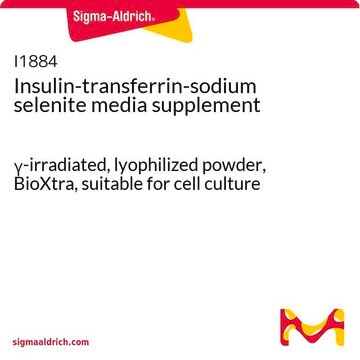11074547001
Roche
Insulin-Transferrin-Sodium Selenite Supplement
suitable for cell culture, lyophilized, pkg of 50 mg (for 5 l medium)
Sinonimo/i:
ITS
About This Item
Prodotti consigliati
Origine biologica
human serum (transferrin)
synthetic (sodium selenite)
Livello qualitativo
Ricombinante
expressed in human cells
Sterilità
non-sterile; 0.2 μm filtered
Saggio
>98% (Transferrin, SDS-PAGE)
>99% (Insulin, HPLC)
>99% (Sodium selenite)
Forma fisica
lyophilized
Confezionamento
pkg of 50 mg (for 5 l medium)
Produttore/marchio commerciale
Roche
tecniche
cell culture | mammalian: suitable
Solubilità
water: miscible
Temperatura di conservazione
2-8°C
Informazioni sul gene
bovine ... INS(280829)
human ... TFRC(7037)
Descrizione generale
Source: Insulin- bovine pancreas; transferrin- human serum; Sodium selenite-synthetic
Applicazioni
Nota sulla preparazione
Storage conditions (working solution): -15 to -25 °C.
Prepare appropriate aliquots and avoid repeated freezing and thawing.
Ricostituzione
Further dilution with culture medium.
Altre note
Codice della classe di stoccaggio
11 - Combustible Solids
Classe di pericolosità dell'acqua (WGK)
WGK 1
Punto d’infiammabilità (°F)
does not flash
Punto d’infiammabilità (°C)
does not flash
Certificati d'analisi (COA)
Cerca il Certificati d'analisi (COA) digitando il numero di lotto/batch corrispondente. I numeri di lotto o di batch sono stampati sull'etichetta dei prodotti dopo la parola ‘Lotto’ o ‘Batch’.
Possiedi già questo prodotto?
I documenti relativi ai prodotti acquistati recentemente sono disponibili nell’Archivio dei documenti.
I clienti hanno visto anche
Il team dei nostri ricercatori vanta grande esperienza in tutte le aree della ricerca quali Life Science, scienza dei materiali, sintesi chimica, cromatografia, discipline analitiche, ecc..
Contatta l'Assistenza Tecnica.








